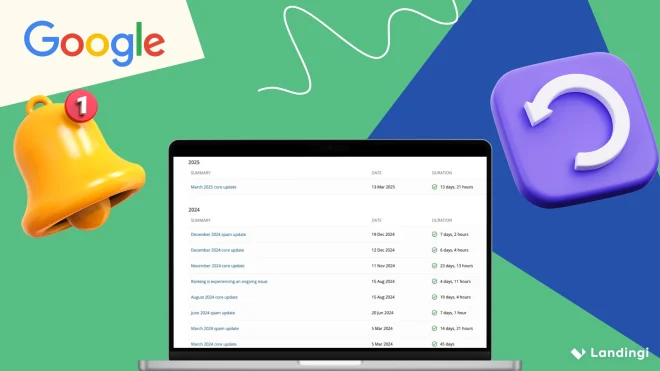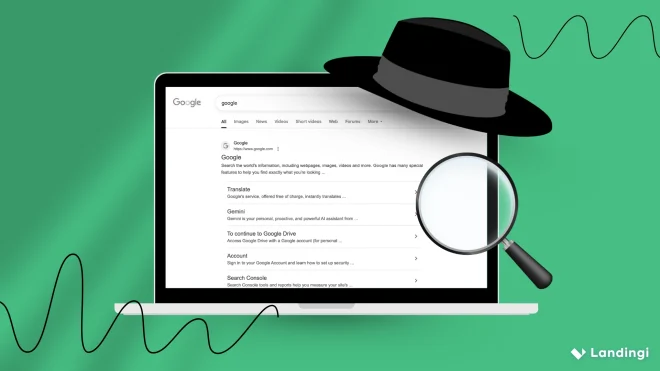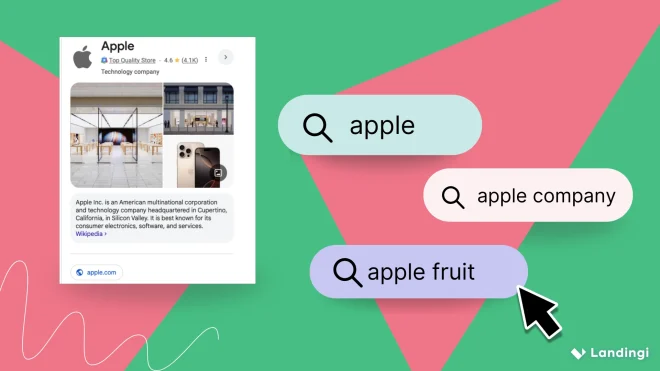A Google SEO update is a change to how Google’s search algorithm ranks content in its search results. These updates—sometimes broad and system-wide, other times narrowly focused—are designed to improve how Google evaluates content, relevance, authority, and user experience. They’re often referred to as Google algorithm updates, and they can affect everything from page rankings to overall visibility across the web.
Every Google SEO update is a signal that search is evolving—and if your content doesn’t evolve with it, you risk losing visibility. That’s why understanding Google algorithm update history isn’t just for SEO experts. It matters for anyone who wants to grow traffic, leads, or conversions through search—especially when organic search drives about 53% of total website traffic.
This article walks you through what recent Google SEO updates have changed, what they tell us about Google’s direction, and how to respond if you want to keep showing up where it counts.

What Are SEO Updates in Google?
SEO updates in Google are changes to how the search engine ranks websites in its search results. These updates—often called “Google algorithm updates”—can be broad core changes or focused tweaks targeting things like spammy content, product reviews, or how helpful a piece of content is. Some updates are minor and go unnoticed. Others shake up the entire SEO world.
Understanding these changes helps you stay visible in search and avoid sudden traffic drops, whether you’re running a B2B SaaS blog or building landing pages for lead generation.
Why Are SEO Google Updates Important?
SEO Google updates are important because they directly affect your rankings, traffic, and visibility in search. A single update can push your site higher—or send it down—overnight.
The most important updates, like broad core updates, often focus on things like content depth, topical relevance, and how trustworthy your site looks. Others, like spam updates, crack down on bad practices: link spam, keyword stuffing, low-quality AI content, or abusing expired domains. If your site uses any of those shortcuts, chances are Google’s updates will catch up to you.
For marketers and content teams, that means SEO isn’t something you set once and forget. It’s ongoing. Staying visible in search means keeping up with recent Google SEO updates, reviewing your content regularly, and making sure your site always delivers real value. If rankings drop, updates help explain why—and point to what you need to improve. If rankings go up, it often means your efforts are aligned with what Google now considers high-quality.
Boost your brand with a professionally designed landing page tailored to your needs.
How to Adapt to Google SEO Updates?
To adapt to Google SEO updates, focus on what Google consistently rewards: helpful content, strong page structure, and websites that serve real users—not just search engines. Every update might bring new adjustments, but the core principles of solid SEO haven’t changed.
After a Google SEO update, you don’t need to overhaul everything—but reviewing underperforming pages is a smart move. Start by updating older content: add better sources, refresh outdated info, tighten up explanations, and remove anything that no longer adds value.
Trust signals matter more than ever. Strengthen your E-E-A-T by including author bios, credentials, real-world examples, and reliable references—especially for topics like health, finance, or legal advice. Don’toverlook technical performance. Fast load times, mobile usability, and clean design all support better rankings. Google continues to weigh Core Web Vitals as part of the overall experience.
It’s also time to ditch SEO shortcuts. Tactics like scaled content, recycled posts from expired domains, keyword stuffing, or aggressive internal linking can hold you back—or worse, get flagged during spam-focused updates. Finally, track what changed. Use Google Search Console to compare pages that dropped with those that held steady or improved. Look for patterns in content depth, structure, or search intent. The more you understand what shifted, the easier it is to adapt—and recover.
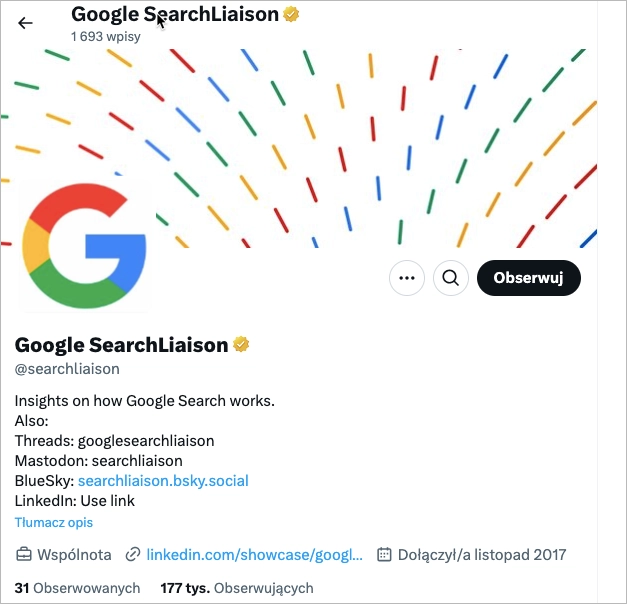
To stay ahead, follow:
- Google Search Central Blog
- Updates from the Google Search Central and Google Search Liaison on X
- Industry insights from Search Engine Journal or Search Engine Land
13 Key Recent Google Core Updates History
Here’s a clear, update-by-update breakdown of the most impactful SEO changes since 2020—plus what to take away from each one.
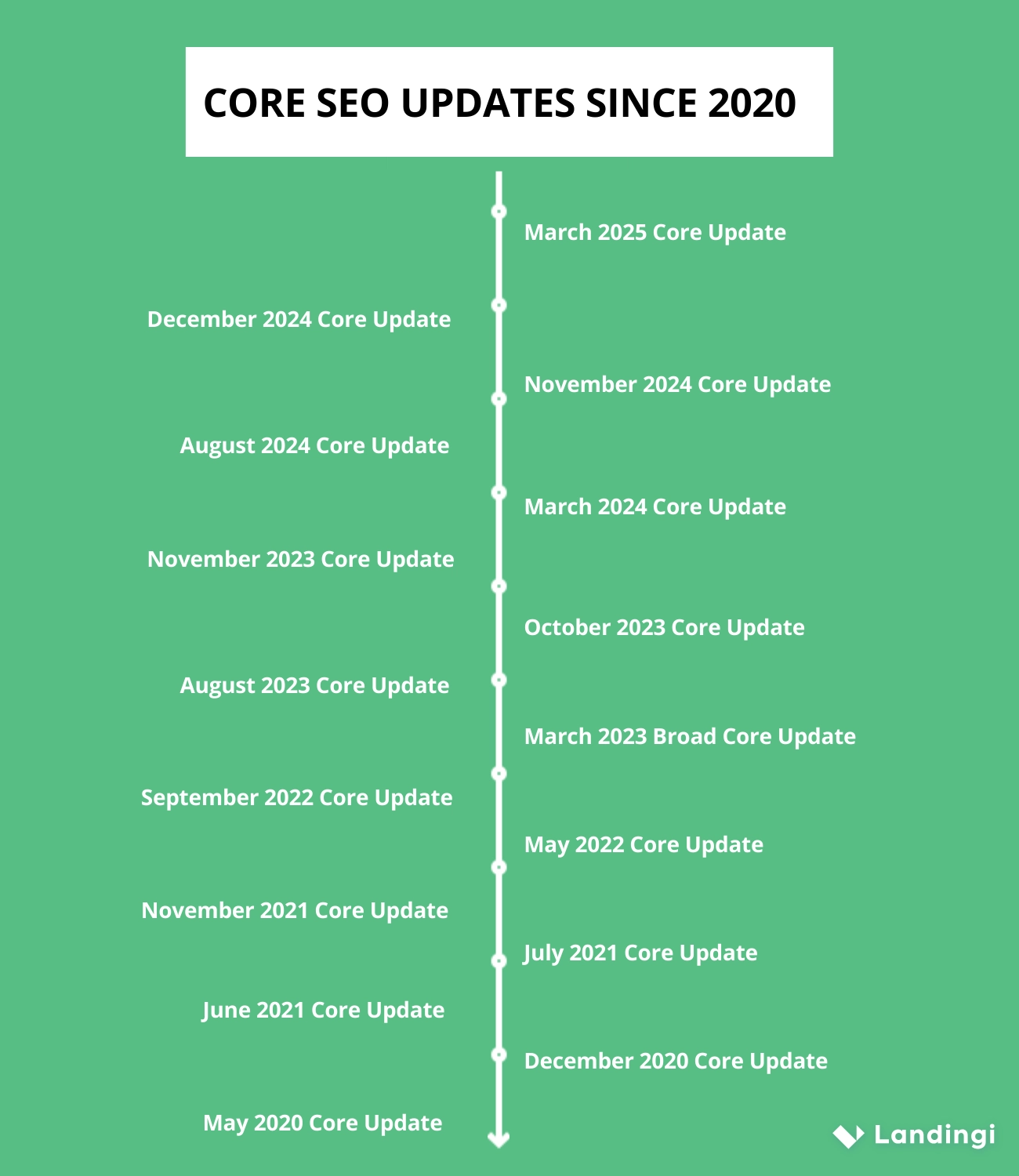
March 2025 Core Update
What changed: Google doubled down on first-hand experience and authorship clarity. Sites with faceless, AI-generated content took a hit.
“This is a regular update designed to better surface relevant, satisfying content for searchers from all types of sites.” — Google Search Central
Do this: Add expert bios, use original examples, and surface your experience—especially for health, finance, and product content.
December 2024 Core Update
What changed: Google launched a core update and a spam update at the same time. The core update focused on matching content more closely to what users are really looking for. The spam update targeted shady tactics like fake authority, keyword-stuffing, and link spam.
Takeaway: Content that’s useful, honest, and made for people—not just search engines—now ranks higher. Sites using shortcuts or tricks are losing visibility.
November 2024 Core Update
What changed: There were no brand-new features—this update simply continued to refine how the Google search algorithm understands quality and intent.
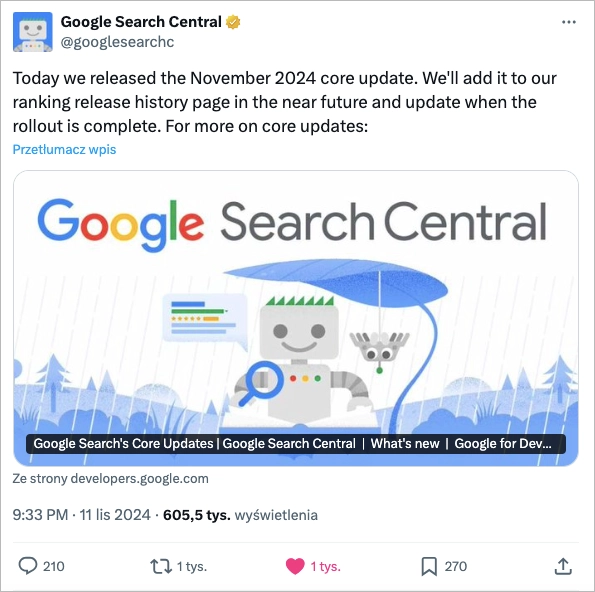
Takeaway: Content that’s written clearly, answers real questions, and puts the user first performed better. Pages focused only on search engine optimization tricks—like keyword stuffing, cloaking, or using weak AI content—started to drop in rankings. Google also continued to clean up spam and low-quality pages that break its guidelines.
August 2024 Core Update
What changed: This update focused on rewarding original, useful content, even from smaller or independent sites, when it best matched the search query.
Takeaway: If you’ve worked on improving your content recently—making it clearer, more useful, or more relevant to users—this update was designed to recognize those efforts. Sites that focused only on ranking tactics, rather than helping real people, likely saw a drop.
Google also noted that this update reflects user feedback gathered over the past few months, and it’s part of an ongoing effort to show a wider variety of high-quality sources. If your site took a hit, Google suggests reviewing their updated core update guidance to better align with what the core ranking system looks for.
March 2024 Core Update
What changed: Google focused on reducing the visibility of content created solely to attract clicks—especially low-value pages written with little regard for usefulness. At the same time, the March 2024 Spam Update was released, amplifying the ranking shifts across the board.
Takeaway: Sites that relied on tactics like keyword stuffing, city-name spamming (e.g., “attractions Berlin”), or low-quality AI-generated content were hit hard. Google also targeted expired domain abuse and site reputation abuse, leading to ranking drops—and in some cases, full deindexation—for sites violating spam policies. The goal was clear: push unhelpful content out of search results and reward pages that actually serve the user. If your site publishes original, relevant, and well-structured content, this update may have worked in your favor.
Build landing pages that evolve with Google’s latest SEO updates—not against them.
November 2023 Core Update
What changed: This update rolled out just weeks after the previous one—but for good reason. Google explained that it focused on a different part of the core ranking system. The goal, as always, was to improve how well search results match what people are actually looking for.
Takeaway: While there weren’t any new features, SEO pros noticed a clear trend: web pages with original, useful, and well-organized content performed better. Sites that relied on repetitive templates, thin articles, or vague keyword-targeting strategies started to drop.
Google also shared a new FAQ to help site owners understand how core updates work—and why they sometimes happen so close together. One key takeaway from the SEO community: this update seemed to favor more diverse search results, giving smaller but high-quality sites a better shot at visibility.
October 2023 Core Update
What changed: Like other core updates, this one was aimed at improving the overall quality of Google’s search results. It adjusted how the algorithm understands which web pages are the most helpful and relevant for each query.
Takeaway: Sites that lost visibility were encouraged to revisit their content and focus on providing more value to users. While Google didn’t target specific issues, the update reinforced its long-standing message: helpful, original content that meets real user needs is what earns—and keeps—rankings. If your content felt thin, outdated, or created just to rank, this update likely exposed it.
August 2023 Core Update
What changed: Google fine-tuned how its systems evaluate content, with a stronger focus on understanding the true value and purpose of each page.
Takeaway: Sites that offer unique, well-written, and informative content may have seen a boost. Those relying on shallow, duplicated, or overly generic pages likely lost ground. While no new systems were introduced, the update reminded site owners that long-term visibility comes from consistently delivering content that’s useful, original, and built around real user needs.
March 2023 Broad Core Update
What changed: As with previous core updates, this one focused on improving the overall quality and relevance of search results. Google continued refining how it evaluates content in relation to user intent.
Takeaway: The update reinforced Google’s message to content creators: focus on producing valuable, well-organized, and genuinely helpful content. Pages that clearly addressed user questions and offered original insight were more likely to benefit, while those built primarily for rankings—without real usefulness—may have dropped.
September 2022 Core Update
What changed: This broad core update aimed to improve how Google ranks content based on overall quality, relevance, and trust. It focused heavily on signals related to E-A-T (Expertise, Authoritativeness, and Trustworthiness), and applied globally across all languages and topics.
Takeaway: The update was separate from—but closely timed with—the Helpful Content Update, and together they reflected Google’s continued focus on rewarding content that puts users first. Impact was noticeable, though not as widespread as some earlier updates. Site owners were encouraged to review performance data and improve content where needed, especially in areas like clarity, source credibility, and topic depth.
May 2022 Core Update
What changed: This update focused on better aligning search results with user intent. Google refined how it evaluates relevance and depth, rewarding content that clearly and thoroughly answers specific queries.
Takeaway: Pages that offered detailed, high-quality answers saw gains in visibility. In contrast, vague or low-effort content lost traction. This update raised the bar for what Google considers useful, pushing content creators to prioritize accuracy, clarity, and real value over surface-level SEO tactics. For many, it marked a turning point—a reminder that solid rankings come from meeting user needs, not just optimizing for keywords.
November 2021 Core Update
What changed: This broad core update rolled out quickly and caused major ranking shifts within the first 24 hours. It focused on improving how Google ranks content based on relevance, authority, and overall usefulness.
Takeaway: Sites with strong, well-aligned content saw gains, while those with thin or outdated pages dropped. The update came during the holiday shopping season, hitting many ecommerce and affiliate sites especially hard. Google confirmed that volatility during rollout is normal and part of its ongoing effort to improve search quality.
React to every Google update by editing, testing, and optimizing your pages inside Landingi—without dev work.
July 2021 Core Update
What changed: Google didn’t share specific details, but confirmed this broad core update made wide-ranging changes to how pages are indexed and ranked. It followed two spam updates in June, which hinted at a continued focus on filtering out low-quality content.
Takeaway: While not officially labeled a spam update, many SEOs noticed patterns suggesting improved spam detection—likely powered by Google’s newer anti-spam AI systems. Sites with weak content, over-optimization, or manipulative tactics may have lost visibility, while pages offering genuine value and a clean SEO structure likely benefited.
June 2021 Core Update
What changed: This was the first part of a two-phase broad core update, rolled out globally starting June 2. Some of the planned improvements weren’t ready, so they were pushed to the follow-up July 2021 Core Update.
Takeaway: The update refined how Google evaluates overall content quality, relevance, and user satisfaction—but without targeting specific sites. Because of the two-part rollout, some sites saw temporary ranking changes in June that were later adjusted in July. It also happened alongside the Page Experience Update, though the two were separate. Google encouraged site owners to focus on helpful content and strong technical SEO to stay aligned with its evolving standards.
May 2020 Core Update
What changed: This update, rolled out from May 4 to May 18, brought major changes to how Google ranks content—making it one of the most noticeable updates in years. It focused on improving result quality, especially in sensitive topics like health, finance, and legal content.
Takeaway: Google started giving more weight to richer content like images, videos, and featured snippets. Local results also became more prominent, with rankings adapting more to each user’s location. Big, trusted sites like Amazon and Pinterest saw traffic gains, while many smaller or niche websites dropped.
December 2020 Core Update
What changed: Rolled out from December 3 to around December 17, this was Google’s third major core update of 2020. It focused on improving how well the algorithm understands content and user intent—especially at a deeper, semantic level.
Takeaway: The update caused significant ranking shifts across many industries. Sites in sectors like real estate, travel, health, and education were heavily impacted. Some experienced visibility swings as large as 100%. Pages that clearly matched search intent and offered strong, high-quality content saw gains. Those with vague or surface-level information lost rankings.
Create mobile-friendly, fast-loading landing pages that match Google’s current ranking criteria.
How Often Does Google SEO Update?
Google updates its SEO algorithm all the time—literally thousands of times each year. Most changes are small and go unnoticed, but some can have a big impact on your rankings.
The major ones are called core updates. These happen roughly every three to four months. In between core updates, Google also pushes out smaller updates, like spam updates. These are more specific and target things like fake backlinks, keyword stuffing, or low-quality AI content. They happen several times a year. On top of that, Google makes continuous improvements behind the scenes. These mini updates happen daily or weekly and help fine-tune search results. They’re usually not announced, but they still affect rankings. So if your traffic drops or spikes and there’s no official update, it might still be part of Google’s ongoing adjustments.
What Are the Popular Local SEO Updates?
The popular local SEO updates include the November 2021 Local Search Update, the November 2021 Spam Update, the March 2025 Core Update, the January 2025 Local/Diversity Update, ongoing 2025 relevance-based changes, and new AI/AR search features.
November 2021 Local Search Update
Refined how Google’s search algorithm evaluates local relevance and proximity, making it essential for businesses to optimize their Google Business Profiles, content, and categories to improve search rankings.
November 2021 Spam Update
Targeted low-quality tactics like keyword stuffing and spammy listings, reminding site owners to follow search engine optimization best practices and maintain clean local citations.
March 2025 Core Update
A major broad core update focused on surfacing more helpful and relevant content across all verticals—including local. It emphasized content quality, user satisfaction, and local intent signals in both organic and map pack results.January 2025 Local/Diversity Update
Prevented the same URL from appearing in both organic results and the local pack. This pushed businesses to diversify landing pages and rethink how Google Business Profile links are structured.
Ongoing 2025 Local SEO Simplification
Google is focusing more on relevance, proximity, and trust. That means local businesses can rank well by maintaining active GBP profiles, gathering quality reviews, and publishing geo-specific content—without needing complex link spam strategies.Emerging AI and AR Features (2025)
AI is helping deliver more personalized, intent-based search results, while AR in Google Maps and local apps is opening new ways to engage users. These changes reflect Google’s push toward richer, more relevant search results in local SEO.
These local SEO updates show a clear direction: Google’s local search engine results pages now prioritize user trust signals, content value, and mobile-first experiences—supported by smarter, AI-driven ranking systems. For local businesses, the path forward means clean profiles, fast mobile sites, and helpful content tailored to local users.
Where to Search If Google Is Rolling SEO Update?
You can track live and past Google updates on the Google Search Status Dashboard, where official updates appear as they’re confirmed.
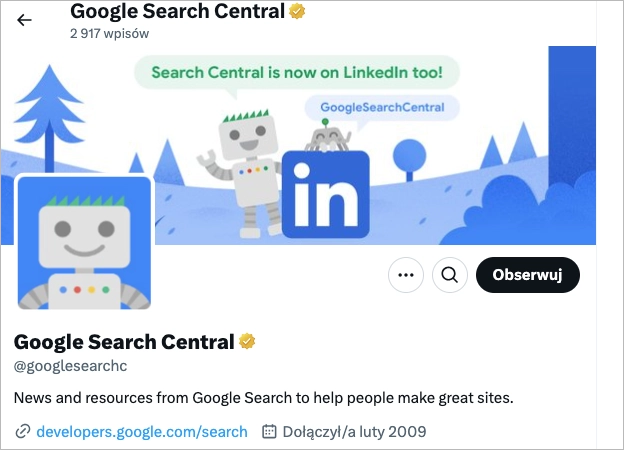
Google also posts update announcements and guidance on its Search Central Blog and shares real-time updates on X through the @googlesearchc profile — that’s the official account of Google Search Central.
Combine Google Search Console insights with Landingi tools to monitor ranking changes and adjust instantly.
Optimize for SEO Updates to Increase Traffic on Your Landing Pages
If there’s one thing the Google algorithm update history makes clear, it’s this: shortcuts don’t last. Every broad core update, spam update, or minor tweak is part of a larger pattern—Google algorithm updates are constantly redefining what “quality” means online. And the bar keeps moving toward content that’s fast, focused, relevant, and genuinely helpful.
For landing pages, that means designing for real users—not just rankings. The pages that continue to thrive after each Google SEO update are the ones that are mobile-friendly, load quickly, and are laser-focused on solving a specific problem at the exact moment someone hits “search.” If you’re building landing pages, treat each Google SEO update as a performance review—not a penalty. What ranks now reflects what actually works.
With Landingi, you can build and optimize landing pages that are ready for every shift in the algorithm. From fast loading times and clear structure to SEO-smart elements like headings, meta tags, and mobile responsiveness—you’re in control, no coding needed. And when the recent Google SEO updates roll out, you’re not caught off guard. You’re ahead of the curve.
Google will keep changing. But with smart optimization and the right platform, your landing pages can keep winning.

